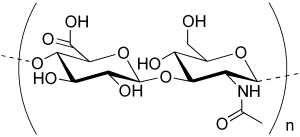New formulations for artificial tears more effective against dryness and ocular discomfort
Hyaluronic acid and xanthan gum in artificial tears
Currently available artificial tear formulations contain hydrophilic polymers such as hyaluronic acid (sodium hyaluronate HA) and/or cellulose ethers that increase viscosity, improve retention time and optimise hydration and lubrication of the ocular surface.
Sodium hyaluronate
 Sodium hyaluronate is an anionic glycosaminoglycan with a viscoelastic rheology.
Sodium hyaluronate is an anionic glycosaminoglycan with a viscoelastic rheology.
Although mainly found in connective tissue, it is also highly concentrated in the vitreous humour and aqueous humour, where it coats the corneal endothelium.
HA is widely used in lubricants used to treat DES because it effectively binds water, resists dehydration and exhibits excellent biocompatibility.
Many studies have revealed that HA protects corneal epithelial cells from damage.
It stimulates epithelial migration and improves the optical quality of the retinal image.
Artificial lachrymals with HA have also been shown to help repair ocular surface irregularities, stabilise the pre-corneal tear film and mitigate the intensity of dry eye symptoms.
Xanthan gum
Another natural polymer used in the most current artificial tear formulations is the xanthan gum (xanthan gum, XG).
Xanthan gum is a complex exopolysaccharide used as a food additive and rheology modifier (rheology is the science that studies the equilibria achieved in matter deformed by stress).
Its chemical structure, rich in OH groups, shows the ability to react with reactive oxygen species (ROS) indicating its role as an antioxidant molecule.
Lo oxidative stress is caused by an imbalance between the production of reactive oxygen species and the ability of the defence mechanisms of biological systems to eliminate stress.
It is now widely recognised that oxidative stress is involved in many acute and chronic diseases, and in the normal ageing process, and also thedry eye has been recognised as a oxidative stress-induced syndrome.
Whatever the initial mechanism, dry eye causes epithelial injury that induces local inflammatory reactions.
It is hypothesised that subclinical hormonal or autoimmune factors, exacerbated by exogenous factors (pollution, local infection, ultraviolet irradiation, tobacco smoke or allergic or iatrogenic phenomena), lead to a cascade of cellular reactions to which apoptosis (programmed cell death) may be closely related.
Lo xanthan gum has rheological properties similar to hyaluronic acid and normal tears; but compared to HA, which degrades rapidly in vivo, it is much more stable over a wide range of pH, ionic strength and temperature.
Hyaluronic acid and xanthan gum synergy

XG and HA also show a synergistic effect on the corneal abrasions which are characterised by acute ocular pain and other symptoms of discomfort affecting the quality of life of patients.
In corneal abrasion, hydration and lubrication prevent friction by decreasing surface disorder and promoting recovery of the corneal epithelial defect.
Hyaluronic acid and xanthan gum are high molecular weight polysaccharides and help protect the cornea by retaining fluid and ensuring hydration.
An innovative hypotonic formulation containing a combination of hyaluronic acid sodium salt, xanthan gum and osmoprotectants such as betaine and glycine is currently being launched.
In addition to moisturising and lubricating, this formulation is designed to compensate tear instability, restore tear volume, provide antioxidant de osmoprotective properties, and thus rebalance the wellbeing of the ocular surface.
Eye surface disorders and tear film
The ocular surface includes the cornea, conjunctiva, eyelids and tear glands, so any disorder affecting these structures can be classified as Ocular Surface Disease (OSD).
 Dry eye syndrome
Dry eye syndrome
Among ocular surface disorders the dry eye syndrome (DES - Dry Eye Syndrome) is a very common condition that has a major impact on the patient's daily activities.
Dry eye syndrome can make everyday activities such as reading, driving, using computers and smartphones difficult.
Symptoms and aetiology
Dry eye syndrome is a multifactorial disorder of the tears and ocular surface characterised by a high osmolarity of the tear film and inflammation of the ocular surface leading to symptoms of discomfort, visual disturbances and instability of the tear film with potential damage to the ocular surface.
Depending on the aetiopathogenetic origin, it is then possible to classify two main forms of dry eye: that due to reduced tear production (hyposecretive dry eye or Aqueous tear-deficient
ent Dry Eye) and that from increased tear evaporation (evaporative dry eye or EvaporativeDry Eye). It is important to consider, however, that the two forms are not mutually exclusive, but rather coexist in a large number of patients.
In addition to DES, the incidence of eye drynessa very common cause of discomfort, is on the rise due to the increasing use of digital tools and in this pandemic period, the prolonged use of the surgical mask, a prescription widely used to counteract the spread of Sars-CoV-2, is often associated with dry eye.
Artificial tears are the most traditionally used therapeutic aid for DES and to counteract dry eye discomfort and should not be confused with eye drops.
They usually consist of a physiological saline solution with a variety of surface lubricants, which improve viscosity and are formulated to replace and/or supplement the natural tear film.
The tear film, the film that covers the corneous-conjunctival surface, is composed of 3 layers: an outer lipid layer produced by the Meibomian glands, a central aqueous layer produced by the main and accessory lacrimal glands, and an inner mucin layer produced by the calyciform cells of the conjunctiva.
Recently, the hypothesis has been put forward that the aqueous and mucin layers are a single mucous/aqueous gel layer.
See also:
- Sodium hyaluronate and dry eye after cataract surgery - Oculista Italiano
- Hyaluronic acid fillers: what are the risks - Oculista Italiano
